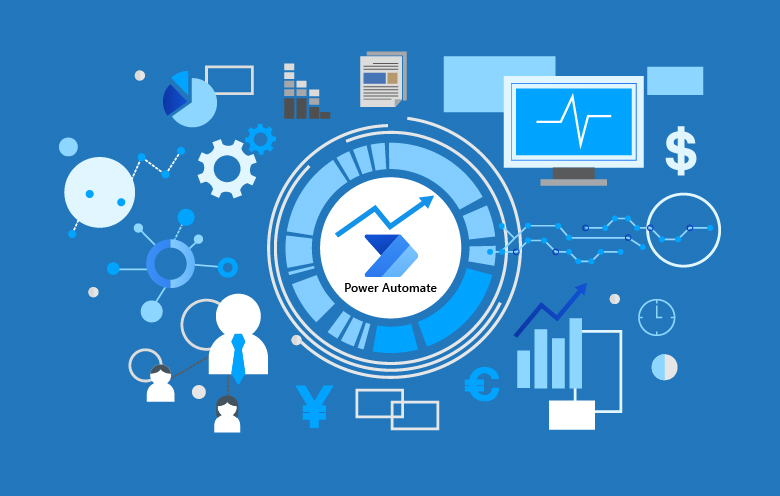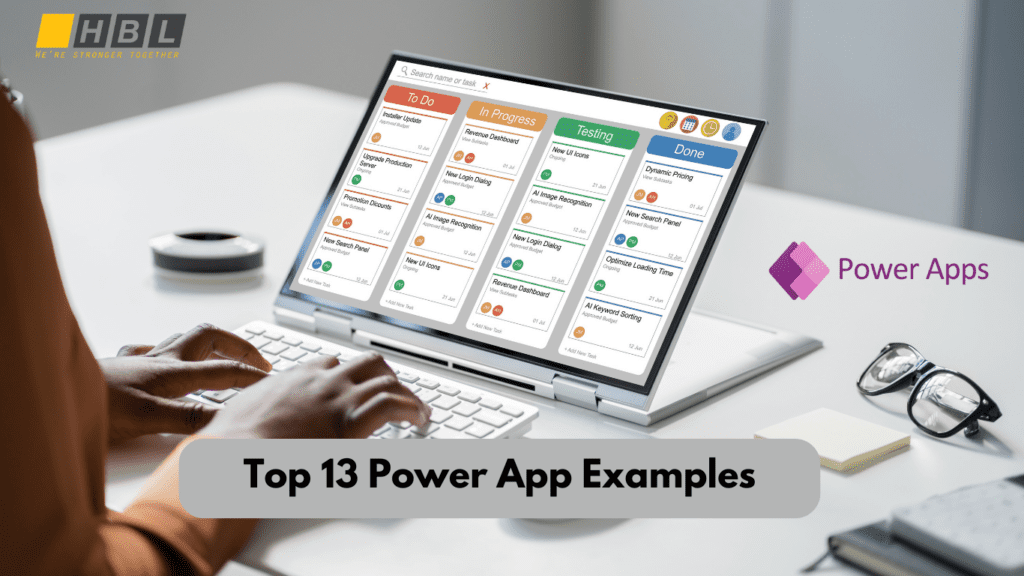Are you Struggling to optimize your business operations? Microsoft Power Apps could be the solution. This user-friendly platform enables you to build custom applications with minimal coding, streamlining workflows and boosting productivity.
Leveraging seamless integration with Microsoft tools like Excel, SharePoint, and Dynamics 365, Power Apps can revolutionize your business processes.
In this article, we’ll explore 13 practical Power Apps examples designed to tackle common business challenges such as time tracking, expense management, and inventory control. Discover how Power Apps can transform your organization.
What is Microsoft Power Apps?
Microsoft Power Apps is a low-code application development platform that empowers users Microsoft Azure create custom business applications rapidly and efficiently. It’s part of the broader Microsoft Power Platform, including Power BI for data analytics and Power Automate for workflow automation.
Power Apps is a cloud-based application development platform hosted on . It is integrated into Microsoft 365 but can also be used as a standalone service. This platform enables users to create both canvas and model-driven apps, designed for web and mobile access.
Power Apps offers a visual, drag-and-drop interface that eliminates the need for extensive coding knowledge. This makes it accessible to a wide range of users, from business analysts to IT professionals. By connecting to various data sources such as Excel, SharePoint, SQL Server, and cloud-based services, Power Apps enables users to build applications that automate processes, improve efficiency, and provide valuable insights.
The platform supports the creation of diverse app types, including canvas apps for highly customized user experiences and model-driven apps based on underlying data structures. These apps can be accessed across different devices, ensuring seamless user interaction. Moreover, Power Apps seamlessly integrates with other Microsoft products, enhancing collaboration and productivity.
With Power Apps, organizations can streamline operations, enhance customer experiences, and drive digital transformation. Whether it’s automating expense reports, managing inventory, or tracking sales performance, the platform offers the flexibility to build tailored solutions that meet specific business needs.
Essentially, Power Apps democratizes app development, allowing organizations to quickly turn ideas into reality without relying solely on professional developers.
Benefits of Microsoft Power Apps:
Microsoft Power Apps offers a multitude of benefits for businesses seeking to streamline operations, enhance productivity, and drive digital transformation:
- Rapid Application Development: Power Apps’ low-code/no-code approach accelerates app creation, allowing businesses to quickly respond to changing market conditions and address specific needs.
- Cost Reduction: By empowering citizen developers to build apps, organizations can significantly reduce development costs and IT backlogs.
- Increased Productivity: Automating manual processes and providing employees with the tools they need to work efficiently leads to increased productivity and job satisfaction.
- Improved Decision Making: Access to real-time data and insights through Power Apps-built applications enables informed decision-making.
- Enhanced Customer Experience: Tailor-made applications can improve customer interactions and satisfaction.
- Scalability: Power Apps can accommodate growing business needs, ensuring applications can scale as the organization expands.
Integration Capabilities: Seamless integration with other Microsoft products and third-party systems fosters a cohesive digital ecosystem.
Top 13 Common Power Apps Examples
Discover how Power Apps is transforming industries. From e-commerce and retail to sales and marketing, here are the top applications making waves.
1. Inventory Management System
Power Apps is a versatile platform ideally suited for developing robust inventory management systems. Its low-code approach, coupled with seamless integration capabilities, empowers businesses to create tailored solutions that optimize inventory control and enhance operational efficiency. By leveraging Power Apps, organizations can gain real-time visibility into stock levels, streamline inventory processes, and make data-driven decisions. Core functionalities include precise inventory tracking, facilitated by barcode or QR code scanning, enabling swift product identification and location.
The platform’s capacity to generate stock-level alerts ensures proactive management, preventing stockouts or overstocking. Moreover, Power Apps simplifies purchase order management, from creation to approval, optimizing procurement processes. Comprehensive product information, including descriptions, images, and pricing, can be efficiently managed within the platform. Inventory adjustments due to returns, damages, or discrepancies are easily recorded, maintaining accurate stock levels. Power Apps’ mobile accessibility empowers warehouse staff to perform tasks on the go, enhancing operational agility. Beyond core functionalities, the platform offers substantial benefits, such as cost reduction through optimized inventory levels and reduced manual intervention.

Increased efficiency is achieved by automating routine tasks, allowing staff to focus on strategic initiatives. Data-driven decision-making is facilitated by real-time insights into inventory performance. Additionally, Power Apps significantly improves data accuracy by minimizing manual data entry errors. The platform’s adaptability makes it suitable for various industries, including retail, manufacturing, warehousing, and distribution.
For retailers, it enables efficient management of inventory across multiple stores. Manufacturers can track raw materials, monitor production output, and manage finished goods effectively. Warehouses benefit from optimized space utilization, streamlined shipment processes, and accurate stock counts.
2. Workforce Management Tool
Microsoft Power Apps revolutionizes workforce management by empowering organizations to create customized, efficient, and user-friendly applications. From tracking employee time and attendance to managing complex talent pipelines, Power Apps streamlines HR processes. Its low-code platform accelerates development, reduces costs, and enhances employee experiences through self-service portals. By integrating with existing systems and leveraging data analytics, organizations can gain valuable insights, optimize workforce planning, and make data-driven decisions to improve overall productivity and performance.
3. Customer Relationship Management System
Application Microsoft Power Apps help enhance and extend CRM capabilities. By allowing users to create custom applications without extensive coding, Power Apps enables businesses to tailor their CRM system to specific needs.

By creating custom applications tailored to specific needs, organizations can streamline lead management, enhance customer service, automate sales processes, and optimize marketing campaigns. Power Apps enables teams to access and update customer information in real-time, fostering better collaboration and decision-making while delivering exceptional customer experiences.
4. Money Management Tool
Its low-code platform enables organizations to create custom applications that streamline budget creation, allocation, tracking, and analysis. From building intuitive expense tracking forms to developing comprehensive budget forecasting models, Power Apps empowers finance teams to work efficiently.

By integrating with existing financial systems, it provides real-time visibility into spending patterns, allowing for proactive adjustments. Furthermore, Power Apps can facilitate collaborative budgeting, enabling cross-departmental input and approval processes. With features like automated notifications and approval workflows, budget management becomes more streamlined and transparent. This flexibility and adaptability make Power Apps an invaluable asset for organizations seeking to optimize their financial performance.
5. Leave management software
Microsoft Power Apps offers a low-code environment that enables HR teams to rapidly develop custom applications tailored to their organization’s specific needs. With Power Apps, employees can easily submit leave requests, check their leave balances, and view leave history. Managers can efficiently approve or reject requests, monitor team leave schedules, and generate reports. The platform’s integration capabilities allow seamless connection with existing HR systems, ensuring data consistency. Additionally, Power Apps can be customized to accommodate various leave types, accrual policies, and approval workflows. By automating manual processes and providing real-time visibility into leave data, Power Apps helps organizations optimize workforce planning and improve employee satisfaction.

6. Customer feedback platform
Microsoft Power Apps can be a cornerstone for creating a robust customer feedback platform. Its low-code nature allows for the rapid development of customized feedback forms, surveys, and analysis dashboards. Businesses can capture feedback through various channels, including in-app, web, and mobile, and centralize data for comprehensive analysis. Power Apps can be integrated with CRM systems to link feedback directly to customer profiles, enabling targeted actions and personalized experiences. Additionally, the platform can facilitate real-time feedback analysis, allowing organizations to identify trends, address issues promptly, and measure customer satisfaction effectively. By empowering businesses to collect, analyze, and act on customer feedback, Power Apps contributes significantly to improving customer experience and driving business growth.

7. Workflow automation with Power Apps
Power Apps, in conjunction with Power Automate, is a formidable tool for automating workflows. While Power Apps focuses on building user interfaces, Power Automate handles the underlying logic and automation. Together, they form a powerful combination for streamlining business processes.

Key applications of workflow automation with Power Apps include:
- Approval workflows: Automate processes like expense approvals, leave requests, and purchase orders.
- Data synchronization: Keep data consistent across different systems by automating data transfers.
- Task assignment: Automatically assign tasks based on rules or user roles.
- Notifications: Send timely notifications via email, SMS, or push notifications based on specific events.
- Integration: Connect various applications and services to create seamless workflows.
For example, a company might use Power Apps to create a mobile app for employees to submit expense reports. Once submitted, Power Automate can route the request for approval based on the expense amount, department, or other criteria. Approvers can review and approve or reject the request directly within the Power Apps app.
By automating repetitive tasks and eliminating manual data entry, businesses can significantly improve efficiency, reduce errors, and enhance employee productivity.
8. Online Learning Platform
Power Apps can be a powerful tool for building engaging and effective online learning platforms. Its low-code approach allows for the rapid development of custom learning experiences tailored to specific audiences and learning objectives.
Key features of an online learning platform built with Power Apps include:
- Course management: Create, manage, and publish courses with ease, including course outlines, learning materials, and assessments.
- Learner management: Enroll students, track progress, and manage user profiles and permissions.
- Content delivery: Deliver various content formats such as videos, documents, and interactive modules.
- Assessments and quizzes: Develop and administer quizzes, tests, and assignments to measure learner progress.
- Progress tracking: Monitor student performance, generate reports, and provide personalized feedback.
- Community building: Facilitate interaction among learners through discussion forums and collaborative tools.
- Mobile accessibility: Create mobile-friendly learning experiences for on-the-go access.

By combining Power Apps with other Power Platform tools like Power Automate and Power BI, you can automate administrative tasks, analyze learner data, and create insightful reports to optimize the learning experience.
9. Quality Assurance Process Tool
Power Apps can be a valuable tool for streamlining and enhancing quality assurance (QA) processes. It can be used to create custom applications that facilitate efficient defect tracking, test case management, and reporting.
Key features of a QA process tool built with Power Apps include:
- Defect tracking: Create a centralized platform to log, assign, and track defects through their lifecycle.
- Test case management: Develop a system for creating, organizing, and executing test cases.
- Test execution: Enable QA testers to record test results, attach screenshots, and provide detailed descriptions of issues.
- Reporting and analytics: Generate reports on defect trends, test coverage, and overall quality metrics.
- Integration: Connect with other tools like bug tracking systems or project management platforms.

By leveraging Power Apps, organizations can improve QA efficiency, enhance collaboration among QA teams, and provide better visibility into product quality.
10. Consumer Research Reports
Power Apps can significantly enhance the consumer research report creation and dissemination process. By leveraging its low-code capabilities, organizations can build custom applications to streamline data collection, analysis, and report generation.
Key applications include:
- Survey creation and distribution: Design and deploy surveys tailored to specific research objectives, collecting data efficiently.
- Data management: Centralize and manage survey responses, ensuring data accuracy and consistency.
- Data analysis: Utilize built-in functions and integration with Power BI to analyze consumer data and identify trends.
- Report generation: Create interactive and visually appealing reports that showcase research findings.
- Collaboration: Facilitate collaboration among research teams through shared access and real-time updates.
For example, a market research firm can use Power Apps to build an application for creating and distributing surveys to consumers. Once data is collected, the same app can be used to analyze responses and generate reports, highlighting key findings. This streamlined approach improves efficiency, reduces errors, and enables faster insights.
11. Question Game App
Power Apps is an excellent choice for creating engaging question-based games. Its low-code environment allows for rapid development and customization of game mechanics.
Key features of a question game app built with Power Apps include:
- Question bank: Store and manage a database of questions with various difficulty levels and categories.
- Game modes: Offer different game modes like multiple choice, true/false, or timed challenges.
- Scoring system: Implement a scoring mechanism to track player performance and provide feedback.
- Leaderboards: Create leaderboards to foster competition and engagement.
- User profiles: Allow players to create profiles, track their progress, and compete with friends.
- Customization: Enable players to personalize their gaming experience with options like avatar selection or theme changes.

For example, a trivia game app can be built with Power Apps to include different categories like history, science, or entertainment. The app can offer various game modes such as single-player, multiplayer, or time-based challenges. By integrating with a data source, the question bank can be easily updated with new content.
12. Sales and Marketing Management System
Power Apps is a transformative tool for sales and marketing teams, enabling the creation of tailored solutions to drive growth and efficiency. By rapidly developing custom applications, businesses can streamline lead management, track sales performance, and optimize marketing campaigns. From capturing and qualifying leads to managing customer relationships and analyzing sales data, Power Apps provides a flexible platform for managing the entire sales lifecycle. Additionally, marketing teams can leverage Power Apps to create engaging customer experiences through personalized campaigns, event management, and customer feedback mechanisms. Integration with other Microsoft tools like Power BI empowers organizations to gain valuable insights into sales and marketing performance, enabling data-driven decision-making. Ultimately, Power Apps empowers businesses to build agile and responsive sales and marketing functions that deliver results.

13. Online Personal Assistant
Power Apps can be leveraged to build a robust online personal assistant (OPA) application. By combining its low-code development capabilities with integration options, it’s possible to create a versatile tool that can handle various tasks.
A Power Apps-based OPA could include features such as:
- Task management: Users can create, prioritize, and track tasks.
- Calendar integration: Sync with existing calendars for scheduling and reminders.
- Note-taking: Capture and organize ideas, to-do lists, and meeting notes.
- Contact management: Store and manage personal and professional contacts.
- Expense tracking: Record and categorize expenses.
- Integration with other services: Connect to email, messaging, and other platforms for seamless interaction.

By utilizing Power Automate for automation and Power BI for data analysis, the OPA can become even more powerful. For instance, automating email management or generating productivity reports.
While Power Apps might not match the sophistication of AI-driven virtual assistants, it can provide a solid foundation for a personalized and efficient OPA tailored to individual needs.
Conclusion
Microsoft Power Apps is a robust platform enabling organizations across industries to optimize processes and boost efficiency. By creating custom applications, businesses can streamline workflows, enhance data management, and improve overall operations.
Our exploration of Power Apps showcases its versatility in addressing diverse organizational needs, from efficient data capture to streamlined project management. The platform’s adaptability allows for the development of tailored solutions that align with specific business challenges.
Power Apps offers a flexible and scalable approach to app development, empowering organizations to achieve their objectives and maintain a competitive edge. Through the creation of custom or pre-built applications, businesses can unlock new opportunities, refine operations, and drive sustainable growth.
See more:
How to Build an Agile Development Team Structure
Data-Driven Business Strategy: The Key to Unleashing Breakthrough Growth




